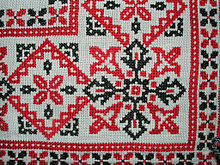Welcome to MyStitchWorld.com. Cross Stitch Distributors
Embroidery. Wikipedia
|
Source:
WIKIPEDIA Gold embroidery on an gognots (apron) of a 19th-century Armenian
bridal dress from Akhaltsikhe. Contents
1 History
1.1 Origins 1.2 Historical applications and techniques 1.2.1 The Islamic world 1.3 Automation 2 Classification 3 Materials 4 Machine 5 Qualifications 6 Gallery 7 See also 8 Notes 9 References 10 External links
History
Traditional embroidery in chain stitch on a
Kazakh rug, contemporary.
Caucasian embroidery
The process used to tailor, patch, mend and reinforce cloth fostered the development of sewing techniques, and the decorative possibilities of sewing led to the art of embroidery. Indeed, the remarkable stability of basic embroidery stitches has been noted:
The art of embroidery has been found worldwide and several early examples have been found. Works in China have been dated to the Warring States period (5th–3rd century BC). In a garment from Migration period Sweden, roughly 300–700 AD, the edges of bands of trimming are reinforced with running stitch, back stitch, stem stitch, tailor's buttonhole stitch, and whip-stitching, but it is uncertain whether this work simply reinforced the seams or should be interpreted as decorative embroidery. Ancient Greek mythology has credited the goddess Athena with passing down the art of embroidery along with weaving, leading to the famed competition between herself and the mortal Arachne.
Depending on time, location and materials available, embroidery could be the domain of a few experts or a widespread, popular technique. This flexibility led to a variety of works, from the royal to the mundane. Elaborately embroidered clothing, religious objects, and household items often were seen as a mark of wealth and status, as in the case of Opus Anglicanum, a technique used by professional workshops and guilds in medieval England. In 18th-century England and its colonies, samplers employing fine silks were produced by the daughters of wealthy families. Embroidery was a skill marking a girl's path into womanhood as well as conveying rank and social standing. Conversely, embroidery is also a folk art, using materials that were accessible to nonprofessionals. Examples include Hardanger from Norway, Merezhka from Ukraine, Mountmellick embroidery from Ireland, Nakshi kantha from Bangladesh and West Bengal, and Brazilian embroidery. Many techniques had a practical use such as Sashiko from Japan, which was used as a way to reinforce clothing.
The Islamic world
Morocco
fly mask embroidery, 18th–19th century
Automation
Hand-made embroidery – Székely Land, 2014
The development of machine embroidery and its mass production came about in stages in the Industrial Revolution. The earliest machine embroidery used a combination of machine looms and teams of women embroidering the textiles by hand. This was done in France by the mid-1800s. The manufacture of machine-made embroideries in St. Gallen in eastern Switzerland flourished in the latter half of the 19th century. Classification
Embroidered Easter eggs. Works by Inna Forostyuk, the folk
master from the Luhansk region (Ukraine)
Japanese free embroidery in silk and metal threads,
contemporary.
Hardanger, a whitework technique. Contemporary.
Embroidery can be classified according to what degree the design takes into account the nature of the base material and by the relationship of stitch placement to the fabric. The main categories are free or surface embroidery, counted embroidery, and needlepoint or canvas work.[14] In free or surface embroidery, designs are applied without regard to
the weave of the underlying fabric. Examples include
crewel and traditional Chinese and Japanese embroidery.
Tea-cloth,
Hungary, mid-20th century
Materials
Phulkari from the Punjab region of India. Phulkari
embroidery, popular since at least the 15th century, is
traditionally done on hand-spun cotton cloth with simple
darning stitches using silk floss.
Laid threads, a surface technique in wool on linen. The
Bayeux Tapestry, 11th century.
Machine
Commercial machine embroidery in
chain stitch on a
voile curtain, China, early 21st century.
Contemporary embroidery is stitched with a computerized embroidery machine using patterns digitized with embroidery software. In machine embroidery, different types of "fills" add texture and design to the finished work. Machine embroidery is used to add logos and monograms to business shirts or jackets, gifts, and team apparel as well as to decorate household linens, draperies, and decorator fabrics that mimic the elaborate hand embroidery of the past. There has also been a development in free hand machine embroidery, new machines have been designed that allow for the user to create free-motion embroidery which has its place in textile arts, quilting, dressmaking, home furnishings and more. Users can use the embroidery software to digitize the digital embroidery designs. These digitized design are then transferred to the embroidery machine with the help of a flash drive and then the embroidery machine embroiders the selected design onto the fabric. QualificationsCity and Guilds qualification in Embroidery allows embroiderers to become recognized for their skill. This qualification also gives them the credibility to teach. For example, the notable textiles artist, Kathleen Laurel Sage, began her teaching career by getting the City and Guilds Embroidery 1 and 2 qualifications. She has now gone on to write a book on the subject. Gallery
|




.JPG/220px-Székely_Land_-_Great_Market_Hall,_2014.09.12_(25).JPG)




















.jpg/93px-Woman's_Robe_a_l'anglaise_with_Petticoat_LACMA_M.66.31a-b_(4_of_6).jpg)
